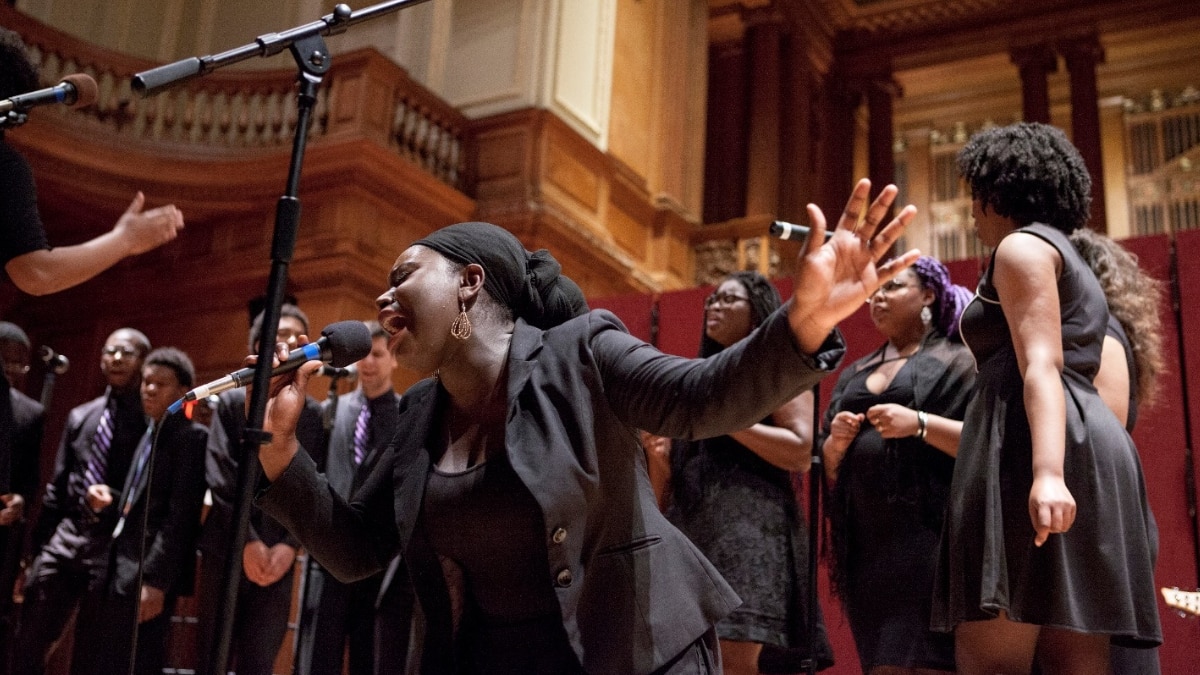Gospel singers in an auditorium at Williams College. Photo credit, Roman Iwasiwka (Creative Commons License 2.0)
Gospel has always played a crucial role in the soundtrack of the struggle. Missional storyteller Jelani Greenidge traces his musical history through six decades of sacred music. Part 1: The ’70s, ’80s, and ’90s.
I grew up in a musical, church-ministry-oriented family. In Black churches, multiethnic churches, and even a few white churches, I joined with my parents, siblings, cousins, and aunts and uncles in regular ceremonies of joyful praise music. We sang everywhere. At special concerts, during holidays and funerals, and at community events. It wasn’t just at church either—we sang at schools, skating rinks, cruise ships, you name it. We sang full-throated birthday choruses in restaurants sometimes, even for strangers. Anywhere Black folks were known to congregate in the Portland area, that’s where we Greenidges developed a reputation to break out in song.
And that’s why I cannot even begin to talk about Black history without talking about the music that shaped me. In this article, I want to offer a look into some of the most important songs, performed by notable gospel artists in the Black community, that have shaped me throughout the decades.
So make sure you’ve got your speakers on, and when you scroll to the embedded song, stop reading and just listen.
Each decade section will focus on just one song, but if you want the full experience, click the links and listen to the bonus tunes. (I threw those in there because there’s too much good music to share and not enough time to write about it all.)
Now then…
I was born in the 1970s.
During my early childhood, no musician or group was more influential than Andrae Crouch & The Disciples. Born to parents in the Church of God in Christ (COGIC) tradition, Andrae was a musical prodigy who started playing at churches at eleven years old. He and his twin sister, Sandra, performed with a variety of groups, first in their native California, then eventually across the U.S. By the time I came along, Andrae was already in his prime, having recorded several albums for Light Records, including the groundbreaking recording Live in London.
Because of my father’s ministry history in New York City with Tom Skinner and the band Soul Liberation, he and my uncle Paul were contemporaries of Andrae Crouch, and they crossed paths several times. In their case, familiarity did not bring contempt. Instead, they recognized musical greatness and were eager to pass it along to my siblings and me. We played Andrae Crouch’s records and tapes so often, we’d memorized all of his arrangements, singing not only all the harmonies and vocal runs but even the drum fills and horn riffs.
That said, one of Crouch’s most famous and influential tunes was his very first—“The Blood Will Never Lose Its Power,” which he composed at the grand old age of 14.
Can you imagine writing something this good at 14? Yeah, me neither.
Andrae Crouch, “The Blood Will Never Lose Its Power”
Even though Andrae wrote it as a young man, the song wasn’t recorded until 1969, which means it took several years of performing in churches and concert halls before African American congregations began embracing it in earnest during the 1970s.
When you consider what was going on at that time, it’s no wonder the song resonated with African American people of faith. Not only were nonviolent leaders like Dr. King killed but so were militant leaders like Malcolm X and Fred Hampton of the Black Panther Party, who advocated bearing arms in a posture of political and economic self-reliance. With so many African Americans being unjustly targeted and ultimately killed, the story of Jesus’s death and resurrection was constantly underscored by the shedding of innocent blood, and the hope was that these deaths, like that of our Savior, would not be in vain. When Andrae Crouch and his people sang of Christ’s blood, “it reaches to the highest mountain, and it flows to the lowest valley,” those lyrics highlighted the highs and lows of the movement, the moments that spanned from rapturous victory to defeat and despair. And so as God’s people sang this song, they were reminded that love would not be defeated by death and that their suffering could be redemptive just as it was for Jesus.
It’s as true now as it was back then. The blood of Jesus has not, is not, and will not ever lose its power.
For more examples of ’70s gospel flavor, check out “Perfect Peace” by Andrae Crouch, Soul Liberation with “Who Is Your Friend?” or The Clark Sisters’ “Is My Living in Vain?”
By the time the 1980s rolled around, Andrae and Sandra Crouch were joined by another musical family in heavy rotation at our house. Four brothers from Detroit, Michigan, called the Winans put their multitalented family on the map, one that would eventually spawn several different gospel and R&B recording artists and groups. Like Andrae Crouch and the Disciples, the Winans were known for soulful harmonies and top-shelf studio instrumentation. Fun fact about the Winans: one of their bands included a young bassist named Fred Hammond, who went on to found the gospel group Commissioned in the 1980s and Radical for Christ (RFC) in the ’90s. (More on him in Part 2, coming next week.)
One of my favorites from the Winans was “Uphold Me,” which only years later did I realize was a setting of Psalm 51. All I remember is the ubiquitous line at the end of the hook: “Whatever you do, Lord, don’t take your joy from me.”
The Winans, “Uphold Me”
This song is remarkably upbeat considering the source material. Psalm 51 is a psalm of repentance, and David was asking the Lord to bring him back to his previous close connectedness, a state that was interrupted not because of God but because of David’s own misdeeds.
Compromises and moral quandaries always occur in the fight for freedom. When the Winans sang these lyrics, their musical pleas mirrored the cries for wisdom and guidance from leaders of the civil rights movement who were trying to build on their previous successes without succumbing to new temptations.
Of course, as a kid, I didn’t understand any of that. But I do remember loving Almond Joy candy bars, and I may or may not have serenaded my mother with a Weird-Al-esque variant of the chorus—whatever you do, Mom, don’t take Almond Joy from me.
For more examples of 1980s gospel flavor, check out “There Is No Failure” by Milton Brunson and the Thompson Community Singers, “I Can’t Tell It All” by Daryl Coley, and “The Potter’s House” by Tramaine and Walter Hawkins.
I came of age in the 1990s, a time when many Black churches and church organizations were beginning to go through the tensions of a generational shift, where the leaders from the baby boom generation who had established churches were beginning to come into conflict with the young upstarts in Generation X who had their own ideas about how to pave a path forward. Not coincidentally, this tension also coincided with the rise of hip-hop. Hip-hop was a multicultural combination of music and culture that emerged from Black and Latino communities in New York in the late ’70s. By the time the ’90s rolled around, hip-hop was beginning to dominate the American pop music scene, and it was making inroads into gospel music.
Nowhere was this generational shift more pronounced than in the music of a young choir director out of Fort Worth, Texas. Kirk Franklin had a bold, audacious style that mimicked the swagger and showmanship of the top hip-hop acts but combined it with contemporary gospel. He didn’t sing or rap, but in his music, he was the ultimate hype man. With a barrage of shouted ad-libs and exhortations, he marshaled God’s people into exuberant praise, like an amalgamation of James Brown, TD Jakes, and Flavor Flav.
That said, even as Franklin captured the attention of young folks, his brash style certainly rubbed certain members of the old guard the wrong way. So when his hit single sampled a bassline from Parliament Funkadelic and featured a verse from Cheryl “Salt” James of Salt N Pepa, he prefaced the song with an introductory warning: “For those who think that gospel music has gone too far…you think we’ve gotten too radical with our message…well, I got news for you. You ain’t heard nothin’ yet.”
Kirk Franklin & God’s Property, “Stomp (Remix)”
One of my enduring memories of this song is of DJing a summer wedding reception, and when “Stomp” played, the whole place went bananas. Black folks, white folks, saved, unsaved, the quiet and reserved, and the drunk and disorderly—it didn’t matter, everybody was gettin’ into it. One young lady on the dance floor said something like, “Wait, ain’t this a gospel song?” and her friend was like, “I don’t know, but TURN IT UP!” In the summer of 1997, “Stomp (Remix)” was a phenomenon, charting #1 on the Billboard R&B charts and #3 on the Billboard Top 200.
Despite some of the controversies surrounding his success, Kirk Franklin simply followed a path that had been blazed by others before him. Seven years before the success of “Stomp,” the Winans made a splash in 1990 with “It’s Time,” a single produced by megastar R&B producer Teddy Riley, who helped create the distinctive sound of that era, known as new jack swing. Two decades earlier in 1969, the Edwin Hawkins Singers had an international hit with “Oh Happy Day,” which charted at #4 in the U.S. and #1 in France. Even James Cleveland and Thomas Dorsey, often considered godfathers of gospel music, were criticized for incorporating jazz and blues influences in their sacred music. The truth is, gospel has always had the potential to cross over into the mainstream because stories of truth, love, hope, and redemption never go out of style.
One of the ironies of Kirk Franklin’s career is that it coincided with a shift from large choirs to smaller vocal ensembles like the various groups he fronted—The Family, God’s Property, Nu Nation, and 1NC. Yet his music, with a heavy emphasis on vocal harmonies and theatrics, kept the choir vibe front and center. When I asked on social media for people to describe their experiences with Franklin’s music, my friend Jaamar summed it up the best: “He just directed the choir,” he said. “And all the listeners were his choir.”
For more examples of classic ’90s gospel flavor, check out “No Weapon” by Fred Hammond, and “Stand” by Donnie McClurkin.
Even with the extra bonus songs, there is no way one article can adequately cover the depth and richness of gospel music throughout the decades, so if you’ve enjoyed these songs—especially if any of them were new to you—I’d encourage you to go to your music subscription of choice and do a deep dive into various strains of gospel music over the years.
In part 2 next week, I’ll show how the turn of the century launched gospel music into a period of experimentation, hybridization, and cultural upheaval. Barriers were crossed, new alliances and controversies developed, and the rules were rewritten for upcoming generations.














